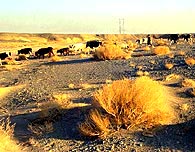 At the beginning of this year, the Water Resources Department of Xinjiang Uygur Autonomous Region broadcast a piece of inspiring news: Starting from this year to 2015, both the central and Xinjiang governments will invest 4 billion yuan (about US$480 million) in the prevention and control of the increasingly serious soil erosion north and south of Tianshan Mountains in Xinjiang. Some ecological preservation projects to which big sums of money have been committed are already under construction.
At the beginning of this year, the Water Resources Department of Xinjiang Uygur Autonomous Region broadcast a piece of inspiring news: Starting from this year to 2015, both the central and Xinjiang governments will invest 4 billion yuan (about US$480 million) in the prevention and control of the increasingly serious soil erosion north and south of Tianshan Mountains in Xinjiang. Some ecological preservation projects to which big sums of money have been committed are already under construction.
With the eroded soil in Xinjiang now measured at 397,683 square mile and with another 140 square mile of oases being taken each year, the seriousness of the problem of soil desertification cannot be ignored. However, if things go as planned ? some 10,038 square mile of fertile land will reappear in Xinjiang in 15 years after construction of current and planned projects to prevent and control erosion.
Xinjiang has been offered a rare opportunity through China?s Western Development Strategy for ecological preservation: Supported by the state, clear water from Bositeng Lake in 2002 began to be channeled into the lower reaches of the Tarim River (the longest river in Xinjiang). Some 515 miles of a branch of the lower reaches of the Tarim River, which had run dry for more than 30 years, began to flow again in November 2001.
Water conservancy projects in the north of Xinjiang in which over 6 billion yuan has been invested are under rapid construction. The regional government has determined to develop a better ecological environment through an economy based on low-yield crops: The goal is to plant 500,000 acres of cotton fields with trees and grass by the end of 2003.
In addition, during the 10th Five-Year Plan period (2001-2005), the total investment in fixed assets in Xinjiang will reach 420 billion yuan (about US$50.72 billion), 60 percent of which is from state and central enterprises.
According to the statistics, investment in the fixed assets in Xinjiang during the 1996-2000 period was 240 billion yuan (about US$29 billion), which was used in construction and operation of a large number of major projects involving traffic, energy, water conservancy, communication that have had a powerful impact on the economic development of Xinjiang. Accomplishments of such projects as the Lanzhou-Xinjiang double-track railway, the south Xinjiang railway construction and its western extension and the key water control project in Uruwati have resolved problems that had proved bottlenecks in the economic development of Xinjiang.
In 2001, the first year of the ?10th Five-Year? plan, 70.6 billion yuan (about US$8.5 billion) was invested in fixed social assets, an increase of 15 percent over 2000. In technical innovation and real estate development, the increase was 23.9 percent and 65.5 percent respectively.
The investment in fixed assets in Xinjiang this year will be 80.7 billion yuan (about US$9.74 billion), a 15.2 percent increase, according to officials. Out of 27 planned major projects on water conservancy, energy, traffic, telecommunications, urban construction and environmental protection, seven projects are expected to be completed within the year including the Keshen Power Plant; No.314 Xiaocaohu-Toksun national road and its related highways; east and north rings of cable telecommunications works; sewage disposal and landscape engineering of Urumqi (provincial capital of Xinjiang). Seven other projects will partially have been finished and gone into operation by the end of this year including a high-quality cotton production base, power network, prospecting and development of three major oilfields. At the same time, no time is being lost in the second stage of a farm-network innovation project in rural Xinjiang. Officials hope that a network of electrical power will be extended, where conditions allow, to townships and that in 2002 both urban and rural areas will come to enjoy equal access to the same power networks.
(From Xinhua News Agency on January 28, 2002, translated by Zhang Tingting for china.org.cn February 15, 2002))
